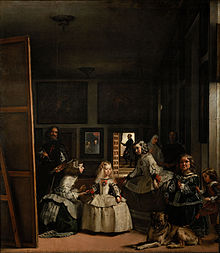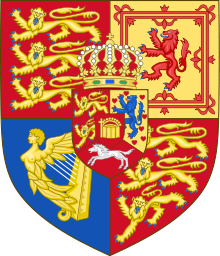- Mise en abyme
-
Mise en abyme (French pronunciation: [miz‿ɑ̃n‿abim]; also mise en abîme) is a term originally from the French and means "placed into abyss".
The commonplace usage of this phrase is describing the visual experience of standing between two mirrors, seeing an infinite reproduction of one's image, but it has several other meanings in the realm of the creative arts and literary theory. In Western art history, "mise en abyme" is a formal technique in which an image contains a smaller copy of itself, the sequence appearing to recur infinitely.
Contents
Heraldry
In the terminology of heraldry, the abyme is the center of a coat of arms. The term "mise en abyme" then meant literally "put in the center". It described a coat of arms that appears as a smaller shield in the center of a larger one (see Droste effect).
A complex example of mise en abyme is seen in the coat of arms of the United Kingdom for the period 1816–1837, as used by King George III. The crown of Charlemagne is placed en abyme within the escutcheon of Hanover, which in turn is en abyme within the arms of England, Scotland and Ireland.
Critical theory
The modern meaning of the term originates with the author André Gide who used it to describe self-reflexive embeddings in various art-forms and to describe what he himself sought in his work.[1] As examples, Gide cites both paintings such as Las Meninas by Diego Velázquez and literary forms such as Shakespeare's use of the "play within a play" device in Hamlet, where a theatrical company presents a performance for the characters that illuminates a thematic aspect of the play itself. This use of the term mise en abyme was picked up by scholars and popularized in the 1977 book Le récit spéculaire. Essai sur la mise en abyme by Lucien Dällenbach.[2]
Medieval examples
While art historians working on the early-modern period adopted this term and interpreted it as showing artistic "self awareness", medievalists tended not to use it.[citation needed] Many examples, however, can be found in the pre-modern era, as in a mosaic from the Hagia Sophia dated to the year 944. To the left, Justinian I offers the Virgin Mary the Hagia Sophia, which contains the mosaic itself. To the right, Constantine I offers the city of Constantinople (now known as Istanbul), which itself contains the Hagia Sophia.
More medieval examples can be found in the collection of articles Medieval mise-en-abyme: the object depicted within itself,[1] in which Stuart Whatling conjectures that the self-references are sometimes used to strengthen the symbolism of gift-giving by documenting the act of giving on the object itself. An example of this self-referential gift-giving appears in the Stefaneschi triptych in the Vatican Museum, which features Cardinal Giacomo Gaetani Stefaneschi as the giver of the altarpiece.[3]
Literature and film
Mise-en-abîme occurs within a text when there is a reduplication of images or concepts referring to the textual whole. Mise-en-abîme is a play of signifiers within a text, of sub-texts mirroring each other. This mirroring can get to the point where meaning can be rendered unstable and in this respect can be seen as part of the process of deconstruction. The film-within-a-film is an example of mise-en-abîme. The film being made within the film refers through its mise-en-scène to the real film being made. The spectator sees film equipment, stars getting ready for the take, crew sorting out the various directorial needs. The narrative of the film within the film may directly reflect the one in the real film.[4]
In film, the meaning of "mise en abyme" is similar to the artistic definition, but also includes the idea of a "dream within a dream". For example, a character awakens from a dream and later discovers that he or she is still dreaming. Activities similar to dreaming, such as unconsciousness and virtual reality, are also described as "mise en abyme". This is seen in the film eXistenZ where the two protagonists never truly know whether or not they are out of the game. It also becomes the prominent plot in Synecdoche, New York. A more recent instance of this can be found in the film Inception.
In literary criticism, "mise en abyme" is a type of frame story, in which the core narrative can be used to illuminate some aspect of the framing story. The term is used in deconstruction and deconstructive literary criticism as a paradigm of the intertextual nature of language—that is, of the way language never quite reaches the foundation of reality because it refers in a frame-within-a-frame way to other language, which refers to other language, et cetera.
See also
- Fractal
- Gödel, Escher, Bach
- Macbeth (1971 film)
- Meta-reference
- Recursion
- Self-similarity
- Story within a story
References
- ^ a b Medieval mise-en-abyme: the object depicted within itself (collection of papers)
- ^ Lucien Dällenbach, Le récit spéculaire. Essai sur la mise en abyme, Paris, Seuil, 1977
- ^ Giotto di Bondone and assistants: Stefaneschi triptych
- ^ Susan. Cinema Studies Key Concepts. New York: Routledge, 2006. Accessed 2009-05-27
Categories:- Artistic techniques
- Metafictional techniques
- Heraldry
Wikimedia Foundation. 2010.



